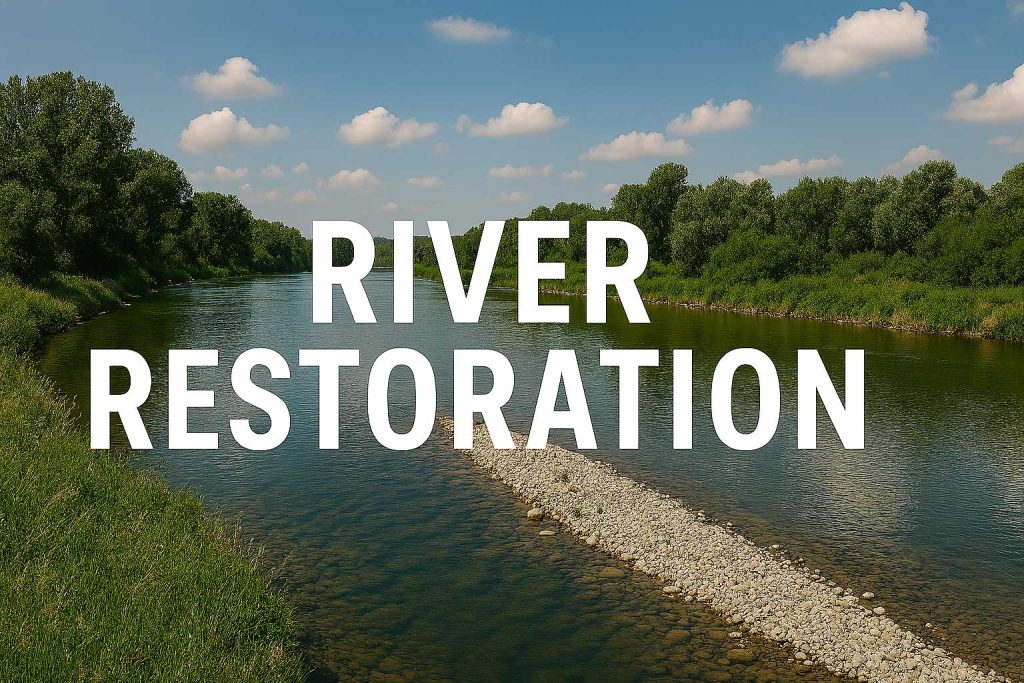Explore river restoration projects worldwide—from Europe to Asia and the Americas. See how rivers are being rewilded and life is returning.
Rivers have shaped human civilizations for millennia. They are the arteries of our planet—carving valleys, nourishing lands, sustaining biodiversity, and connecting ecosystems from mountain springs to the sea. But centuries of damming, dredging, pollution, and urban sprawl have silenced many rivers’ natural rhythms. Now, a global movement is rising to give rivers their pulse back. River restoration projects, from small local efforts to sweeping continental initiatives, are working to rewild rivers, restore floodplains, revive biodiversity, and build resilience against climate change.
Let’s dive into the “why, how, and where” of this powerful river renaissance—across Europe, the Americas, Asia, and beyond.
🌎 Why Restore Rivers?
Rivers are not just water flowing downhill. They are dynamic ecosystems that support:
- Rich biodiversity: From freshwater fish and migratory birds to aquatic plants and insects.
- Flood regulation: Natural floodplains absorb excess water like sponges.
- Water purification: Wetlands and riparian zones filter out pollutants.
- Cultural and recreational value: Rivers are central to many traditions and offer countless benefits for communities.
Yet over 60% of the world’s rivers are now considered degraded—fragmented by dams, polluted by runoff, and disconnected from their floodplains. Restoration is a response to this crisis—healing landscapes, protecting life, and restoring balance.
🛠 How Are Rivers Restored?
River restoration isn’t about returning rivers to a prehistoric state—it’s about re-establishing key natural processes. The methods vary based on local context, but commonly include:
- Dam removal: Reopening river continuity for fish and sediment flow. Read more about dam removal
- Meander restoration: Reconnecting straightened rivers with their natural curves.
- Floodplain reconnection: Restoring wetlands and side channels.
- Bank stabilization with natural materials: Using logs, roots, and vegetation rather than concrete.
- Reforestation and buffer zones: Planting native trees and grasses along banks.
- Pollution reduction: Reducing agricultural runoff and wastewater inflow.
These actions help rivers breathe again, creating habitats, reducing erosion, and improving water quality.
🇪🇺 Europe: A River Renaissance
Europe is at the forefront of river restoration, with thousands of projects underway, backed by ambitious environmental policies and funding mechanisms like the EU Water Framework Directive and EU Biodiversity Strategy.
🔹 Case Study: Loire & Allier Rivers, France – Letting the River Roam
The Loire and Allier Rivers in France are among Western Europe’s last wild rivers, and their restoration has become a landmark example of large-scale rewilding. Through the “Plan Loire Grandeur Nature”, France cancelled dam projects, removed barriers, reconnected floodplains, and restored hundreds of hectares of gravel islands and wetlands—especially along the Allier, a critical spawning ground for Atlantic salmon. This holistic effort has revived natural meandering, boosted biodiversity (including otters, beavers, and sand martins), and created a model for balancing ecological health with rural development and flood protection.
🔹 Case Study: Drava LIFE, Croatia
Along the Drava River, which flows through five countries, the Drava LIFE Project is restoring side channels, gravel islands, and floodplain forests. The goal? To bring back the river’s natural dynamics, protect endangered species like the little tern and black stork, and enhance flood protection.
🔹 Dam Removal in France & Sweden
France has removed hundreds of obsolete dams, including the Sélune River’s massive Vezins and Roche-Qui-Boit dams, reuniting fish with their spawning grounds. Sweden has focused on restoring forest streams once used for timber floating, removing blockages and adding wood debris for fish habitat.
🇺🇸 North America: Reconnecting Wild Waters
In the U.S. and Canada, river restoration has gained momentum, often led by coalitions of scientists, NGOs, tribes, and local communities.
🔹 Case Study: Elwha River, USA
The Elwha River on Washington’s Olympic Peninsula once hosted one of the largest salmon runs in the Pacific Northwest. But for a century, dams blocked this flow of life. In one of the largest dam removal projects in the world, the Elwha and Glines Canyon dams were taken down, allowing salmon to return after 100 years—and igniting a cascade of ecological recovery.
🔹 Urban River Makeovers
Cities like Los Angeles and Toronto are rethinking urban waterways. The LA River, once a concrete drainage ditch, is seeing sections “re-naturalized” with green corridors and public spaces. In Toronto, the Don River is undergoing extensive floodplain restoration to reduce urban flooding and enhance wildlife corridors.
🌏 Asia: Restoring Rivers for People and Nature
Asia’s rivers are among the world’s most iconic—and most stressed. Yet innovative projects are beginning to take root.
🔹 Case Study: Yangtze River Basin, China
Once notorious for pollution and damming, the Yangtze is now central to China’s ecological restoration efforts. The Yangtze River Protection Law (2021) enforces conservation zones, pollution control, and dam regulations. The Chinese government has also designated “Ecological Redlines” to safeguard crucial riverine habitats.
🔹 India’s Revival Efforts
In India, restoration is being driven both by cultural reverence and ecological urgency. Efforts to clean and rejuvenate the Ganga and Yamuna rivers include sewage treatment projects, riparian forest restoration, and community-led cleanups. Meanwhile, in Kerala, after devastating floods in 2018, authorities are rethinking river engineering to allow natural flows and floodplains.
🌐 Global Trends & Challenges
- Climate change: Restoration helps mitigate droughts and floods—but extreme weather can also threaten restored sites.
- Urban pressure: In fast-growing cities, balancing development with river restoration requires visionary planning.
- Biodiversity wins: Projects worldwide have brought back beavers, salmon, otters, and rare birds.
- Public support: Success often depends on community involvement and cross-sector collaboration.
🌿 The Future is Flowing
The river restoration movement is not just ecological—it’s poetic. It reflects a shift in values: from controlling nature to coexisting with it. Around the world, rivers are being set free, and with them, entire ecosystems and communities are finding renewal.
From the mighty Amazon’s headwaters to the braided streams of the Alps, rivers are starting to run wild again.


